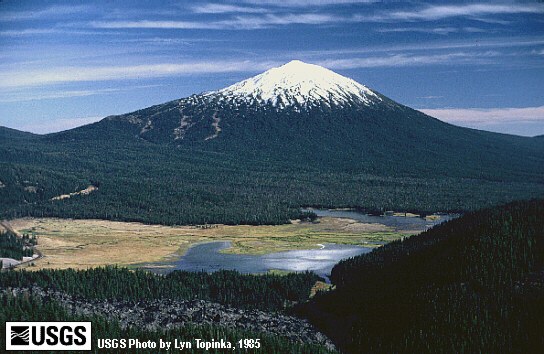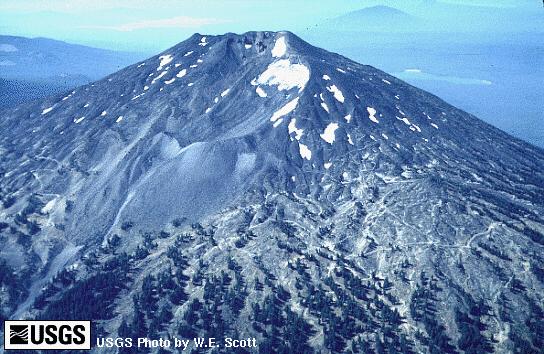
Aerial View of Mount Bachelor and Sparks Lake
-
Mount Bachelor
-- Geographic Setting, Geologic and Eruptive History
The Three Sisters area contains 5 large cones of Quaternary age -
North Sister, Middle Sister, South Sister, Broken Top, and Mount Bachelor. ...
Mount Bachelor, which is between 11,000 and 15,000 years old is the
youngest of these volcanoes in the Cascades.
-- Excerpt from:
Hoblitt, et.al., 1987
-
Field Trip Guide to the Central Oregon High Cascades
This field excursion to the central Oregon High Cascades
highlights aspects of Quaternary volcanic and glacial history in the vicinity of
Mount Bachelor (formerly Bachelor Butte) and South Sister.
Part 2 (Bend Area) portion of the field excursion to the central Oregon High
Cascades highlights aspects of the ash-flow tuffs in the Bend area.
The guide contains brief descriptions of the stops, and some of the key
features and interpretations of the stops are discussed further in the
paper by Hill and Taylor at the end of the guide.
-- Scott and Gardner, 1990
|
The Mount Bachelor volcanic chain is located in the Deschutes National Forest,
20 kilometers west-southwest of Bend in central Oregon.
The north flank of Mount Bachelor is readily accessible during all season from the
Cascade Lakes Highway (U. S. Forest Service and Deschutes County Road 46). Several paved and
graded gravel roads head west from U. S. 97 and lead to other parts of the chain.
Mount Bachelor Ski Area operates chairlifts to the
summit during the summer as well as the ski season (weather permitting).
-- Excerpt from: Scott, 1990, IN: Wood and Kienle, 1990,
Volcanoes of North America: United States and Canada:
Cambridge University Press, 354p.
|
-

[Map,17K,InlineGIF]
Bend/Sisters/Santiam Pass/McKenzie Pass Area
-

[Map,23K,InlineGIF]
Newberry Volcano and Vicinity
Ride the Sunrise Lift to mid-mountain, walk over to the Summit Lift, and ride it to the top.
Turn right (from Bend via the Cascade Lakes Highway) into entrance road to
Sunrise Lodge; follow road 0.3 miles to parking lot. ...
Bring lunch, water, and suitable clothing. Be
prepared for cold winds and foul weather. The only restrooms
are located in the lower level of the lodge.
Ride the Sunrise Lift to mid-mountain, walk over to the Summit Lift,
and ride it to the top.

Aerial view, Mount Bachelor, by W. E. Scott, USGS/CVO
Summer sightseeing begins in July and runs through September.
For more information on dates, times, and prices call 1-800-829-2442
-- Information courtesy
Mt. Bachelor Inc. Website, May 1999
The summit of Mount Bachelor
has numerous vents, most of which discharged
basaltic andesite lava flows. The summit vents and plugs exposed in the
headwall of the cirque are arrayed in a northwest-southeast-trending cluster
that forms an elongate summit ridge. The vents are marked mostly by low, blocky
domes but also by several shallow collapse craters. Pyroclastic material is
scarce, forming only a few remnants of cones of dense scoria that are older than
most of the domes vents. The scarcity of pyroclastic material at the summit and
on the flanks of the cone indicate that at least the latter summit eruptions
were dominantly effusive.
Views from the summit include
Newberry volcano
to the southeast and the
Mount Bachelor volcanic chain
to the south. Farther to the south and southwest,
numerous shield volcanoes form the bulk of the High Cascades.
Diamond Peak,
Mount Thielsen, and
Mount Scott
(on the east side of
Crater Lake)
are prominent distant peaks. To
the southwest and west, the upper
Deschutes River valley
contains several lakes
dammed by lava flows. The four northern ones
(Sparks,
Elk,
Hosmer,
and, except for brief periods,
Lava)
have no surface outlets; water drains out through the
permeable post-glacial lava flows and emerges as springs along the down-valley
margins of the flows.
Little Lava Lake
(and, during high water,
Lava Lake)
usually forms the head of the
Deschutes River.
The
Three Sisters,
Broken Top,
and the silicic highland of Taylor (1981) (renamed the
Tumalo volcanic center
by Hill, 1988, and Hill and Taylor, 1989)
east of Broken Top dominate the northern
view, with
Three-Fingered Jack,
Mount Jefferson,
Mount Hood, and
Mount Adams
in the distance.
Excerpts from:
"Climb (?) Mount Bachelor", "The Summit", and "View from the Top" information from:
Scott, Gardner, Sarna-Wojcicki, (eds.), 1989,
Guidebook for Field Trip to the Mount Bachelor-South Sister-Bend Area,
Central Oregon High Cascades:
USGS Open-File Report 89-645; and
Scott and Gardner, 1990,
Field Trip Guide to the Central Oregon High Cascades:
Oregon Geology, v.52, n.5 and n.6
|
-
Deschutes National Forest
-- Link courtesy U. S. Forest Service
-
MORE Useful Sites
-- CVO Menu, includes links to Volcano Info, Seismicity, Hydrology, etc.
-
Travel and Tourism Links
-- CVO Menu, includes links to Nearby Cities, Attractions, Recreation, etc.
-
Weather and Road Conditions
-- CVO Menu, includes links to Weather Forecasts, DOT's, Pass Reports, etc.
-
 Mount Bachelor Menu
Mount Bachelor Menu
|



